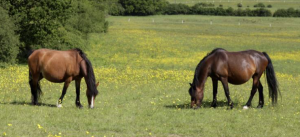 5 Tips for Summer Pasture Maintenance: J & J Hay Farms is here to help you with you summer pasture maintenance. Whether you keep your horse on small acreage or you have rolling hills as far as the eye can see, pastures should be managed to ensure that grass provides optimum nutrition for horses. Each farm is different, but there are some management strategies to keep in mind no matter the size or location of your farm.
5 Tips for Summer Pasture Maintenance: J & J Hay Farms is here to help you with you summer pasture maintenance. Whether you keep your horse on small acreage or you have rolling hills as far as the eye can see, pastures should be managed to ensure that grass provides optimum nutrition for horses. Each farm is different, but there are some management strategies to keep in mind no matter the size or location of your farm.
Soil testing:
Soil profile, including mineral content and pH, varies greatly from farm to farm and region to region. For this reason, soil testing is recommended in order to determine if and what kind of fertilizer may be necessary. Typically, your local Cooperative Extension Service office can help you with a soil test, and supply a report with fertilizer recommendations.
Stocking rate:
Stocking rate is important if you are relying on pasture to meet the majority of your horse’s nutritional needs, and is defined as the number of acres available per animal.
For an average 1,000-lb (450-kg) horse, two acres of well-managed, established pasture is recommended during the growing season. If you have four horses, you’d need a minimum of eight acres. If stocking rate is higher, for example if you keep four horses on four acres or five horses on two acres, supplemental forage, such as hay, and possibly a grain concentrate may be necessary to meet the horse’s daily nutrient needs. Higher stocking rates stress pastures and reduce the amount of available nutrients.
Rotation:
A rotational grazing plan keeps grasses healthy. Just like horses, plants need a chance to rest and rejuvenate after stress (heavy grazing, drought, etc.).
Horses are able to graze right to the ground, and hooves can cause compression and divots in the ground. The higher the stocking rate, the more important it is to have a rotational grazing plan. Even with only two paddocks, rotation can work.
When pastures are 7-10 inches tall, turn out horses. When the pastures are grazed down to 3-4 inches, allow the pasture to rest and turn out horses in the other area. Additional pasture areas will improve results. Ideally, rotating in four- or five-week cycles is recommended but will depend on the stocking rate and amount of space available.
Sacrifice area:
A sacrifice area, also known as a drylot or animal concentration area, is a place where horses can be turned out when pastures are too wet, have not grown sufficiently to allow grazing, or when pastures are resting.
Sacrifice areas are also useful for horses who cannot be maintained on pasture, such as those with metabolic health concerns. Shelters, water sources, and sometimes feeders are often placed in sacrifice areas. Sacrifice areas should be large and comfortable enough to accommodate the number of horses on the farm. Plenty of room should be left for horses to avoid pecking-order squabbles.
Mowing and sward height:
Regular mowing helps reduce weeds. Mowing height is an important consideration. Since grasses store energy in the bottom of the plant closest to the ground, mowing too short is counterproductive. Mowing to a height of 3-4 inches is generally appropriate. Pastures can also be dragged to break up and dry manure.
Be sure to consider a quality ration balancer or vitamin and mineral supplement that will supply horses with nutrients not found in sufficient quantities in pasture. Micro-Max is a low-intake concentrated source of vitamins and minerals for mature horses and is appropriate for horses on pasture.
Keep water and salt sources clean and readily available. The effort put into pasture maintenance will yield nutritious forage for your horses year after year.
J & J Hay Farms sells only first quality hay period. You can see it, smell it and touch it in every bale we sell.
Article source: KER.
